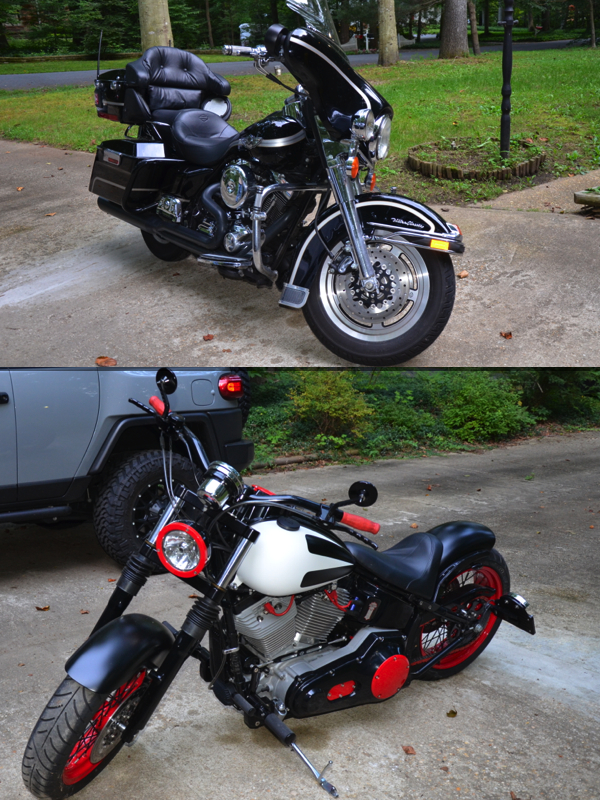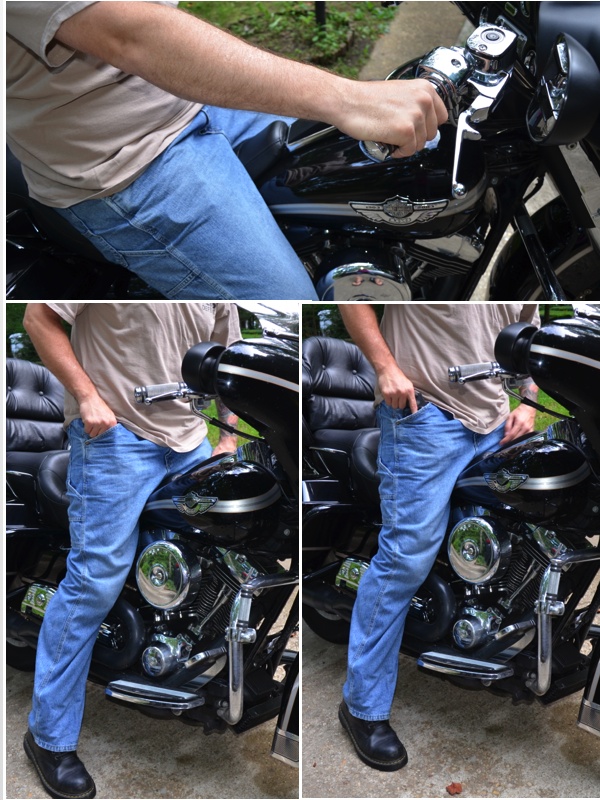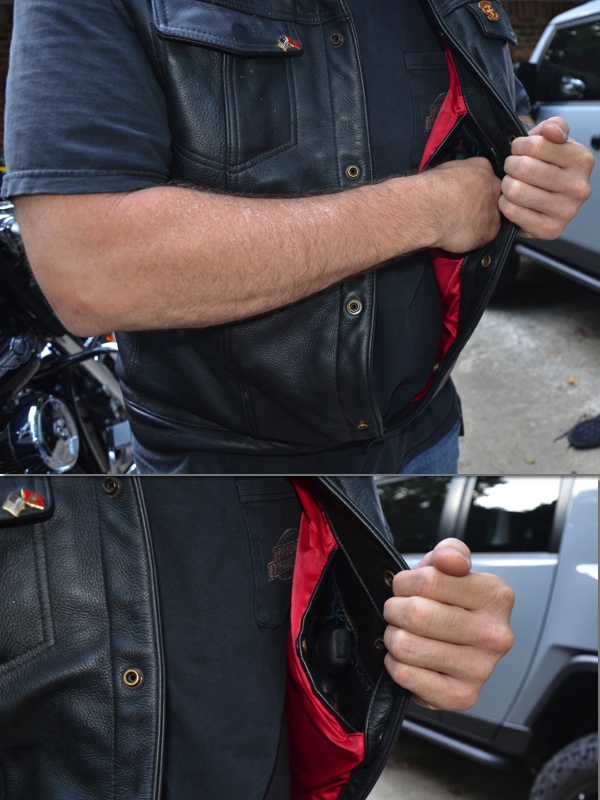
Motorcycle riding continues to increase in popularity. For some it’s because of increased gas prices. For others it’s a sense of freedom, a way to temporarily unplug from the world. And for others it’s something they grew up doing and it’s become a way of life. The reasons why we ride are as varied as the number of different makes, models, and styles of motorcycles on the road. I fall into the “way of life” category and log in the neighborhood of 10,000 miles per year. My yearly riding profile consists of daily commuting, errands, rallies, and at least two long-haul (2.5k+ mile) trips.
Through all these years and miles on a motorcycle, I have managed to carry in some form the majority of the time. My experiences while riding, my evolution as a firearms instructor, as well as student questions have given me time to really think about concealed carry while riding. My thoughts on the “why,” “how,” and strategies for success have evolved over the years based on these factors.
Plausibility
A quick Google search will bring up a lot of links to forum opinions on how to carry, as well as ads for various motorcycle accessories for carrying while riding. I even found one forum where someone (a naturally right-handed shooter) said, “When riding I carry left handed.... It would have to be an extreme situation when I would actually shoot from my bike, moving or stopped, but I have trained that way.” What isn’t readily available is information on a strategy for concealed carry while riding.

To come up with a strategy, you first need to apply the plausibility principle: What are the most probable and plausible situations you could encounter while riding where you would need to defend yourself with a firearm? The situations while riding a motorcycle are basically the same as if you were in a car -- the situations all involve being stopped. The quick run to the store, getting gas, stopped at a traffic signal or sign, taking a break at a rest area, and the list goes on of the different places you would stop. The major difference is that sitting on a motorcycle, you don’t have an intermediate barrier to give yourself extra time to react and to provide cover or concealment.

Let’s quickly cover that statement about carrying left-handed for “just in case” scenarios while riding. To be clear, I have heard this from multiple sources (students as well as strangers at rallies). Is it possible that someone could threaten your life while riding down the road? Absolutely! This usually comes from being tailgated or having your right of way taken. In these situations, your first reaction is to get out of the way, come to a stop, or some other evasive maneuver, not draw your gun. I submit that even if in some post-apocalyptic anomaly where someone starts shooting at you while riding, your first action should still be escape, evade, or safely come to a stop. You are already in a compromised position by being on two wheels and with no steel cage surrounding you. Taking one hand off the bars to draw a weapon only magnifies your bad position.
Consistency
The second area I like to look at when developing a strategy is consistency. We all have limited time, money, and energy, so whatever we do that is different from our primary carry method, some portion of time needs to be dedicated to training. For this reason, I recommend that whenever possible, carry in the same manner and position while riding as you do when walking around.
I recognize that this isn’t always possible, based on things like the type of motorcycle you ride and how you’re positioned on the bike. If your everyday carry is inside-the-waistband appendix and you ride a sport bike, I am pretty sure this wouldn’t be comfortable (or good for the tank paint). In a case like this, let’s say the person switches to a shoulder holster while riding. They will most likely be wearing a jacket or vest for concealment. This alternative carry method must be trained and should be done wearing the same cover garment worn while riding. The context of wearing the cover garment provides the sensory perception for setting and developing the neural pathways for a consistent response.
Methods
As I said earlier, a Google search will bring up more than enough opinions on the various positions to carry. I will break it down into the categories of on-body and off-body, the pluses and minuses of each, and some tips.
On-Body

In my opinion, on-body carry is preferable to off-body whenever possible. Remember the plausibility principle and when you are most likely to need to defend yourself -- while stopped or at some point after you have parked and dismounted. It’s a big plus to have the gun readily available if it’s needed, and you don’t have to worry about finding a private spot to transition from a storage location.
Now for the downside. I was a Motorcycle Safety Foundation Certified Instructor as a RiderCoach for my state. I began every class with the statement, “There are two types of riders: those that will go down and those that have gone down.” That said, the typical on-body carry positions don’t dissuade me from still recommending on-body whenever possible. The gun safety (or safeties) and holster (covering the trigger) should be more than enough to keep the gun from going “bang” in the event of a crash.
Depending on where it is on your body, there’s a good chance you will land on the gun. And depending on the type of retention, it’s possible it could come out of the holster when you go down. So keep in mind where you carry and what the chances are of it being an impact area should you go down. Some of the impact areas are subject to your body type, type of motorcycle, and your position while riding. But there is one type of carry method I don’t think anyone should ever consider while riding: small-of-the-back carry. It’s bad enough you have worry about being injured in an accident, so why put a hunk of metal and polymer right up against your spine and increase the potential of severe injury or paralysis?

One final thing to consider with on-body carry. When riding down the road, you are “in the wind” and it’s pushing your pant legs up, making the bottom of your shirt flap around (and sometimes ride up), as well as trying to push items out of your pockets. This is why I highly recommend wearing a jacket, vest, or some other cover garment that has a strong zipper (or snaps) and will not easily ride up. Also, if you are going with pocket carry, make sure to use a good holster that has enough tack and/or is shaped such that it will stay in your pocket (or the pocket has a closure). One note on pocket carry: if you need to access the gun immediately upon stopping, you most likely will need to shift your body to open up room in the pocket and pant leg to complete the draw. If this applies, make sure it is incorporated into your training.
Off-Body

Going back again to my days of teaching new riders, here’s another quote from every class: “Everyone has a different definition of risky behavior or what risk they are willing to accept.” Maybe you aren’t willing to accept the perceived additional risk of on-body carry while riding, or maybe off-body is your preferred method out of necessity. Off-body is storing the gun in a saddle bag, tour pack, tank bang, or some other variant not attached to you while riding.
The plus side of this method is you don’t have to worry about the on-body downsides, meaning the consequences associated with a crash or your cover garment riding up and exposing your gun. On the minus side is the fact that you don’t have immediate weapon access upon stopping.
Here are some things to consider with off-body carry. When stopping, are you going to transition to on-body? If so, develop a routine when stopping, such as finding a private area to perform the transition without detection and then moving to your desired parking spot (or gas pump). Another solution that’s convenient for on- or off-body motorcycle concealed carry is the fanny pack. I know people who use this method and, when they stop, the first thing they do on dismount is pull out the fanny pack and strap it on. I’ve heard that the fanny pack screams “guy with gun,” but the evidence doesn’t support that argument.

When carrying your firearm in one of your bags, understand that, if you are in an accident, the contents of your bags may be strewn everywhere (aka the “yard sale”). Because of this possibility, I strongly recommend putting the gun not only in a holster but also in another bag or, better yet, invest in a “vault” made for your motorcycle.
Final Thoughts
You may be wondering why I didn’t cover rides where you cross state lines. There are a couple of reasons for this. First, because it is no different than travelling in a car. You must plan ahead and decide your strategy for carry and storage accordingly. Second, with laws constantly changing, you have to do your own research and contact the necessary authorities for clarification.
Hopefully I have provided the information needed to develop a strategy for motorcycle concealed carry while enjoying the freedom found on the back of a motorcycle.
Learn More about our sister site, Fix My Hog.

Is there a forum or facebook page etc. For Motorcyclists who carry?
When riding from State to State I highly recommend the app "legal heat". It shows you all the information the different states have. You can click on open carry, concealed carry, state law or federal law. This app refreshes every 48 hours.
Deyck, I have asked these questions for years and finally got tired of buying holsters that are not realistic for someone on a motorcycle. Your article is informative and helpful! I got so tired of purchasing holsters that I have designed my own compartment, patented and I am now manufacturing it. It is initially designed for the touring Harley's, but will eventually be made for the majority of the bikes. I would love to chat sometime and you can give me your thoughts. Sincerely, Dale Budd, Founder/Owner Cache & Carry Concealed Compartments, Corp. Cell: 717-542-4165
Not concerned with carrying while riding. Gun will be on body. What do you do with gun when going into work.
GLOCK MAKES A FANNY PACK WITH ZIPPERS ON BOTH SIDES HAVE EASY GRAB STRAPS THAT PULL THE ZIPPERS DOWN. GLOCK.COM
Another option is a shirt/holster combo called Packin' Tees. It's a snug fitting tee or sleeveless shirt with strong Velcro on both sides that comes with a heavy duty Velcro elastic holster which can be positioned for best comfort and draw. I've been riding all my life and carrying all of my adult life, and I choose not to give consideration to the additional injury my gun may cause. I only consider ensuring it will remain secured in the event of a crash.
None
While attending a CCW class for Arizona, the instructor recommended that motorcycle riders carry, granted Arizona is a Constitutional State which means everybody and anybody can be armed concealed or not; but the emphasis was on protection for the mc rider. The rider is already vulnerable enough, they need all the advantage they can get. I highly recommend exposed carry in a holster. I carry a .357 or a 1911 both in a shoulder holster. My advantage is I am left handed.
Sorry, but if you're honestly considering returning fire while actually riding, you have serious issues. Just as shooting from a moving car will get you in trouble with the law (it's flat out illegal in all States, and you had better have a really good excuse for it, and even then you will probably be charged with reckless discharge) , doing it from a bike is also hazardous to your health just from the crash standpoint. The idea that some even consider it is just plain foolish. Frankly, outside of the consideration of what that pistol might do to you if you crash while wearing it, carrying while riding is little different than in a car, and that's all about personal preference. I've been using the same carry technique for my various bikes as I have my cars for years, it's all about the season and the preference .
Obviously, the best is in a vest or jacket pocket. If considering a shoulder type holster, the butt down is my preferred.